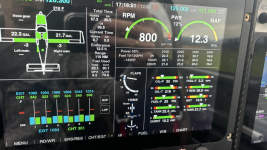vinzer
Well Known Member
Hello All!
I have a question about the oil temperature in my RV10. I conducted an extensive run-up on the ground and pushed it the way so my highest CHT went to 410°F for a minute, while all other CHTs ranged from 380°F to 410°F at the same time. The oil temperature rose to 218°F. After setting the engine to nearly idle and leaning, I waited. Within 5 to 10 minutes, the CHTs decreased to 320°F ... 350°F range, but the oil temperature remained at 218°F with no change. Taxing back to the hangar took another 7 to 10 minutes, and by the end, the oil temperature was still 217°F.
I understand that CHT and oil temperature are different parameters and cylinder cooling is way much faster process, but I expected the oil temperature to correlate with the CHTs in some way. The engine is an IO-540, the oil temperature sensor is tested and serviceable, and the oil cooler is a standard one (I believe 11 rows), which is the default for this kit from VANs. The oil cooling hose at the back of cylinder 6 is not obstructed.
I've always had the oil temperature on the high side but never checked it on the ground. Is this behavior of the oil temperature normal for such conditions , or should I start checking the venatherm ?
Almost forgot to add here: after some time I removed the cowl and measured temperatures on the surface of the oil filter and inside of the oil cooler's fins.
The oil filter surface is 152F and and oil cooler fins are 108F. Again I understand that oil filter cools slower but oil cooler still contains a hot oil so temperature difference should not be that much, should it ?

I have a question about the oil temperature in my RV10. I conducted an extensive run-up on the ground and pushed it the way so my highest CHT went to 410°F for a minute, while all other CHTs ranged from 380°F to 410°F at the same time. The oil temperature rose to 218°F. After setting the engine to nearly idle and leaning, I waited. Within 5 to 10 minutes, the CHTs decreased to 320°F ... 350°F range, but the oil temperature remained at 218°F with no change. Taxing back to the hangar took another 7 to 10 minutes, and by the end, the oil temperature was still 217°F.
I understand that CHT and oil temperature are different parameters and cylinder cooling is way much faster process, but I expected the oil temperature to correlate with the CHTs in some way. The engine is an IO-540, the oil temperature sensor is tested and serviceable, and the oil cooler is a standard one (I believe 11 rows), which is the default for this kit from VANs. The oil cooling hose at the back of cylinder 6 is not obstructed.
I've always had the oil temperature on the high side but never checked it on the ground. Is this behavior of the oil temperature normal for such conditions , or should I start checking the venatherm ?
Almost forgot to add here: after some time I removed the cowl and measured temperatures on the surface of the oil filter and inside of the oil cooler's fins.
The oil filter surface is 152F and and oil cooler fins are 108F. Again I understand that oil filter cools slower but oil cooler still contains a hot oil so temperature difference should not be that much, should it ?

Last edited:




